Encouraging grazing and perennial cover
Incentives for working lands and pastures at the state level have declined and are repeatedly under threat in the federal farm bill. Encouraging perennial cover through extended rotations, grazing, and forage has proven soil health benefits. Expanding support for grazing and working lands in Iowa can improve soil health and support livestock producers.
· Healthy soils act like a sponge, providing reserves when precipitation is low and means to soak up excess when precipitation is high.
· Healthy soils have more microbes living in them which can better provide the nutritional needs of crops naturally.
Promoting soil health
Healthy soils retain more water, lessening runoff during heavy rains and helping crops survive drought. Promoting living cover on the landscape reduces soil erosion protecting our soils for future generations.
· By focusing on building soil health, the state can provide positive incentives rather than penalties to farmers taking steps to improve water quality.
· The potential for promoting carbon sequestration through soil health practices could be a huge opportunity for farmers.
· On-farm practices could lessen agricultural pollution and improve soil health, such as:
- New policies enacting new basic standards for assessing soil health and the regeneration of topsoil.
- Increased efforts to promote continuous roots on the ground through cover crops, extended rotations, grazing of cool season grasses, and new markets for small grains and perennial crops.
Creating value through healthy soils
Protecting soil through agricultural conservation practices can also produce financial benefits to farmers by reducing costs of production and increasing yields. Transitioning to these practices includes costs and risks. To overcome these barriers, farmers need support and incentives.
· Practices that build soil health can be more profitable.
- A side-by-side comparison of farm practices showed that a combination of practices – including no-till, cover crops, nutrient optimization, and crop rotation – led to a cost savings throughout the farm budget that outweighed the costs.
· Conservation benefits, including improvements in soil health, often go unrecognized and unrewarded.
- Conservation practices can lower insurance claims by making crop yields more resilient to harsh weather such as droughts and excess rainfall.
- Crop insurance was the second most volatile insurance category, following federal flood insurance, from 2012 to 2016.
Supporting research
Natural Resources Conservation Service (NRCS) is focusing on defining common metrics for soil health.
· Eight states have passed common language defining soil health: California, Hawaii, Maryland, Massachusetts, New York, Oklahoma, Utah, and Vermont. Soil health is defined as “the continued capacity of surface and subsurface water ecosystem to function as a vital living ecosystem that sustains plants, animals, and humans.”
- Having this common language, combined with common metrics, will make advancing policy possible.


